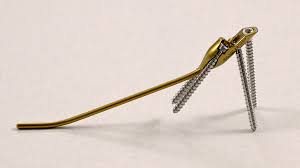Fixing extraarticular fractures with Radius Intramedullary Nails (DRIM-Nails)
As a leading Orthopaedic implant manufacturer, HCM Orthocare offers a comprehensive range of intramedullary nails, including radius intramedullary nails. Our nails are designed to provide stability and support to fractured or broken bones in the forearm. The nails are made from high-quality surgical-grade stainless steel or titanium, ensuring maximum strength and durability. Our radius intramedullary nails are available in a range of sizes and lengths to suit different patient needs. We understand the importance of providing accurate and reliable medical devices, which is why our products are manufactured under strict quality control measures and comply with international standards. At HCM Orthocare, we are committed to providing our clients with the highest quality orthopedic implants at competitive prices. We have a team of experienced professionals who ensure that our products meet the needs and expectations of our customers.An radius intramedullary nail is a metal rod that is inserted into the medullary cavity of a bone and across the fracture in order to provide a solid support for the fractured bone. Intramedullary nailing is currently considered the “gold standard” for treatment of femoral shaft fracture
he ulna intramedullary nail is solid, round, and unreamed. Distal locking can be achieved by passing one or more locking screws through the eight transverse grooves on the distal end. The nail allows static, dynamic, and single-cortex interlocking through round, oval, and oblique proximal holes.
In response to various clinical complications following fixation of distal radius fractures using CRPP and ORIF techniques, a collaboration between the University of Balgrist, Disrad AG, the Hcm Commission’s Hand Expert Group, the AO’s Development Incubator and 41medical has witnessed the design and development of an intramedullary implant indicated for unstable A3 and A2 extraarticular fractures of the distal radiu
Distal radius fractures are the most common orthopedic injury accounting for 17.5% of all fractures in adults. These fractures generally occur from a fall on the outstretched hand, and roughly 50% of distal radius fractures are intraarticular. Diagnosis is made clinically and radiographically with orthogonal radiographs of the wrist. Treatment can be nonoperative or operative depending on fracture stability and fracture displacement as well as patients’ age and activity demands

The implantation of plates and screws in the distal radius is appropriate for unstable, intraarticular, compound, and/or comminuted fractures and allows stable fixation compatible with early mobilization on only protective removable splinting. Drawbacks of such internal fixation, however, is the necessity of additional soft-tissue injury for the exposure during implantation; thereafter, the potential to irritate tendons near the components, causing tendinopathy and possible tendon rupture. Currently, the most common complications directly related to distal radius plate fixation include tenosynovitis, tendon attrition, and rupture often necessitating hardware removal. The most obvious obstacle when adopting CRPP besides the limited stability of the construct and the necessity of lengthy immobilization is the extension of pins outside of the bone which can cause an increased risk of infection
